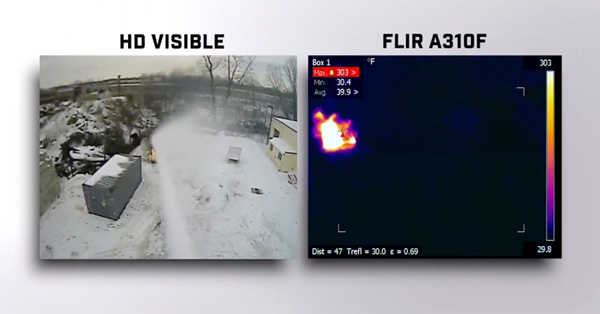Swedish hospital maintains heating and ventilation system with thermal imaging
In hospitals climate control is of critical importance, to ensure both hygiene and comfort for the patients and personnel. That is why the technical staff of a Swedish hospital, has acquired a FLIR thermal imaging camera to inspect and maintain the Heating Ventilation Air Conditioning (HVAC) system. The FLIR thermal imaging camera is an ideal tool for this, but it also sees use in other areas such as building insulation inspections and electrical maintenance inspections. It has certainly proven its worth, according to the maintenance technicians of the hospital.
"The camera provides us with the right information and allows us to make well based decisions with regard to maintenance of the HVAC system and troubleshooting all kinds of building issues", says one of the hospital technicians. "The air temperature in the hospital should be 22 °C and the air coming from ventilation ducts should be 18 °C. There are thermometers installed in certain parts of the building and these provide feedback for the automated HVAC system we use. This gives us a general overview, but if we want more specific information about the airflows and temperature distribution in a room we need the FLIR thermal imaging camera."

"From time to time complaints might arise from patients about a room being too hot or too cold", he adds. "With the thermal imaging camera we can quickly assess whether there is actually something wrong in that room. If nothing is wrong, the screen of the thermal imaging camera allows us to immediately show the patient that the temperatures are perfectly normal in the thermal image. And if there is a fault the FLIR thermal imaging camera helps us to find the problem much faster, allowing a quick repair."
Operation room
Some hospital rooms require even more detailed monitoring, with the operation room as a prime example. "For different types of operations different ambient temperatures are necessary. And a close control of air circulation is an obvious necessity to prevent contamination with airborne pathogens. We therefore regularly check and closely monitor the HVAC systems of the operation rooms with the FLIR thermal imaging camera."
Faults that the two technicians sometimes find in the hospital's HVAC system are clogged radiators or blocked ventilation ducts. "But there is much more we can do with the camera, such as inspecting fuse cabinets and mechanical components in the ventilation system for faults, checking whether the district heating shunt group is cooling the warm water down to the right temperature and even the backup batteries in the server room."

Insulation defects
During a recent building project large parts of the building where renovated. The FLIR thermal imaging camera was used to verify whether the insulation was working perfectly. "Inspections with the FLIR thermal imaging camera showed that there was some warmth leakage at the window stills and that there was insufficient insulation in the attic roof. We also found that some of the radiators were not installed correctly. Based on the information from the thermal imaging inspections these faults were corrected, ensuring that the new renovated parts of the building are well insulated."

Thermal imaging vs spot pyrometers
According to the hospital's technicians the camera has been a great addition to their assortment of tools. "Before we had this thermal imaging camera we had to base our maintenance inspections on contact measurements". "We had to either touch warm components manually or use a spot pyrometer. In our experience none of these methods are as quick, effective and accurate as a thermal imaging camera."
Thermal imaging cameras have important advantages compared to spot pyrometers. "The spot meter just gives you a value of a small area. Using it for inspections is very labor intensive and it lacks the overview that a thermal imaging camera gives. On a thermal image you can immediately scan an entire area for thermal hot or cold spots and see at once where the problem is located."


The details may vary, but a spot pyrometer is basically similar to a thermal imaging camera with one pixel as in that it tells you the temperature of one spot. A FLIR thermal imaging camera will provide the same accurate temperature readings, but it gives you not one, but thousands of temperature readings at the same time. With a spot pyrometer it is very easy to miss crucial information. "The spot pyrometer gives you a number. The thermal imaging camera presents an image of the entire area. This makes a huge difference. You can immediately see the temperature distribution in the entire area and quickly spot problems that would otherwise remain undetected."
Versatile tool
The first time they saw a thermal imaging camera in action they immediately knew they needed to get one for themselves. "It started when we hired an external consultant for electrical maintenance who used a FLIR thermal imaging camera. We immediately realized that this was a versatile tool that could be used for a multitude of different applications within our hospital, so we bought a FLIR BCAM thermal imaging camera from a local distributor."
The FLIR BCAM thermal imaging camera is not currently marketed by FLIR. Its modern replacement is the FLIR Ebx-Series. The FLIR Ebx-models have an image quality of up to 320 x 240 pixels and include the features you need to make well informed building decisions like built-in insulation and dew point alarms. The cameras are specifically designed for building inspections such as, HVAC heating and cooling issues, air flow, moisture detection, insulation problems and other heat related building issues.


